267
From drooling dogs, running rats, and pecking pigeons we have learned much about the basic processes of learning. But conditioning principles don’t tell us the whole story. Today’s learning theorists recognize that learning is the product of the interaction of biological, psychological, and social-
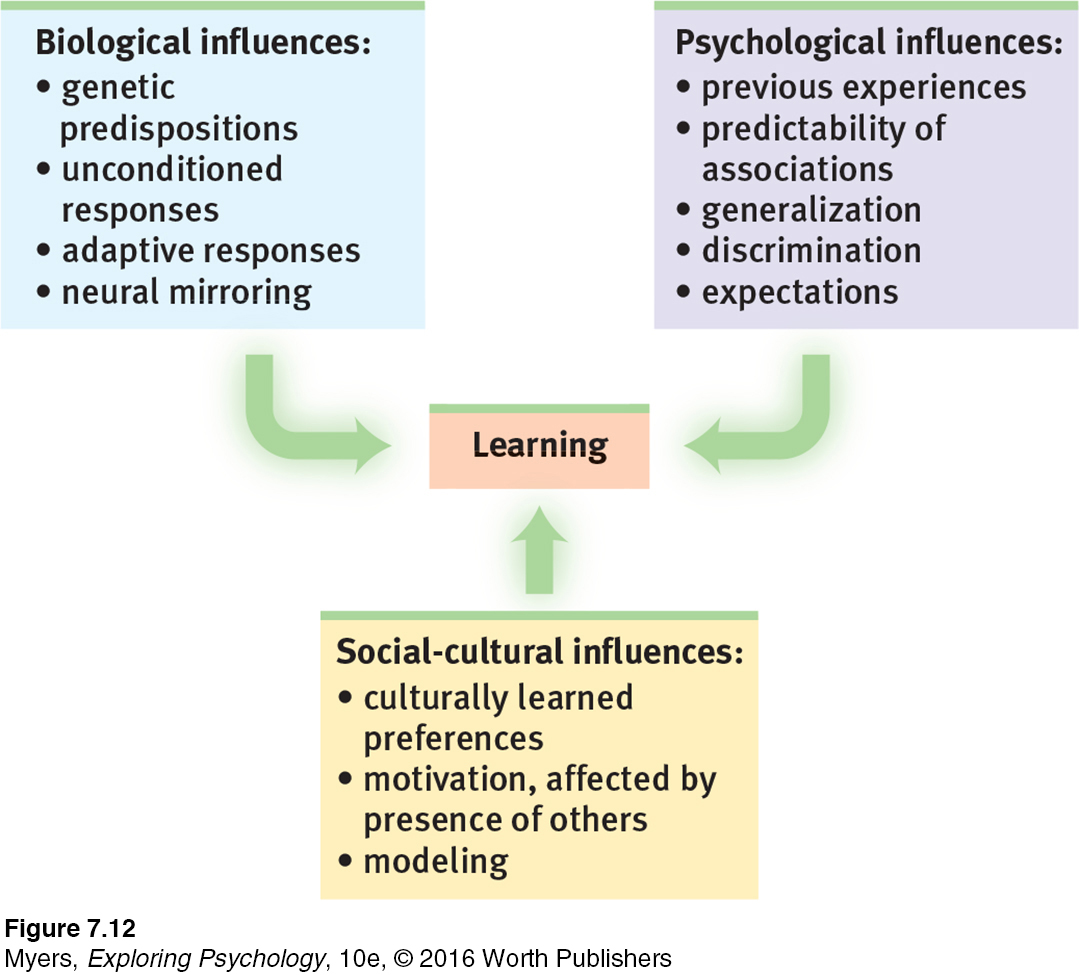
Biological Constraints on Conditioning
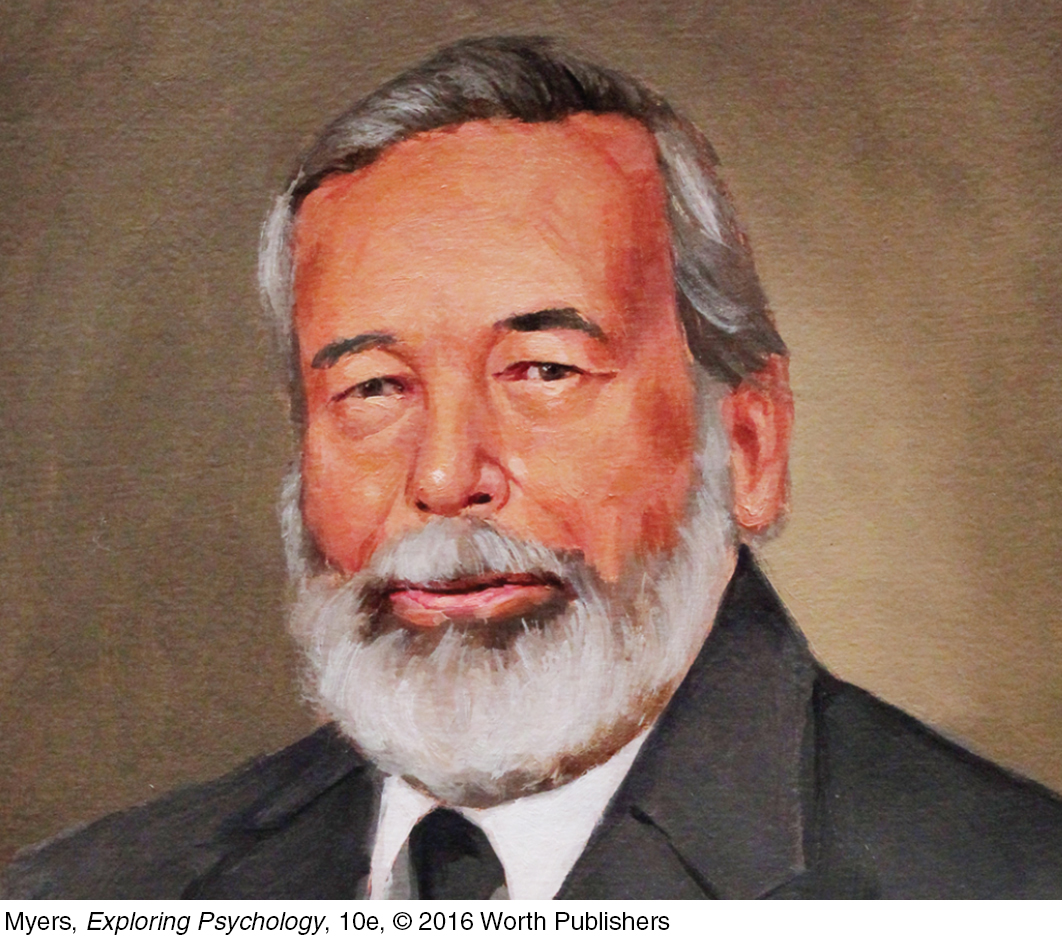
7-
Ever since Charles Darwin, scientists have assumed that all animals share a common evolutionary history and thus share commonalities in their makeup and functioning. Pavlov and Watson, for example, believed the basic laws of learning were essentially similar in all animals. So it should make little difference whether one studied pigeons or people. Moreover, it seemed that any natural response could be conditioned to any neutral stimulus.
Limits on Classical Conditioning
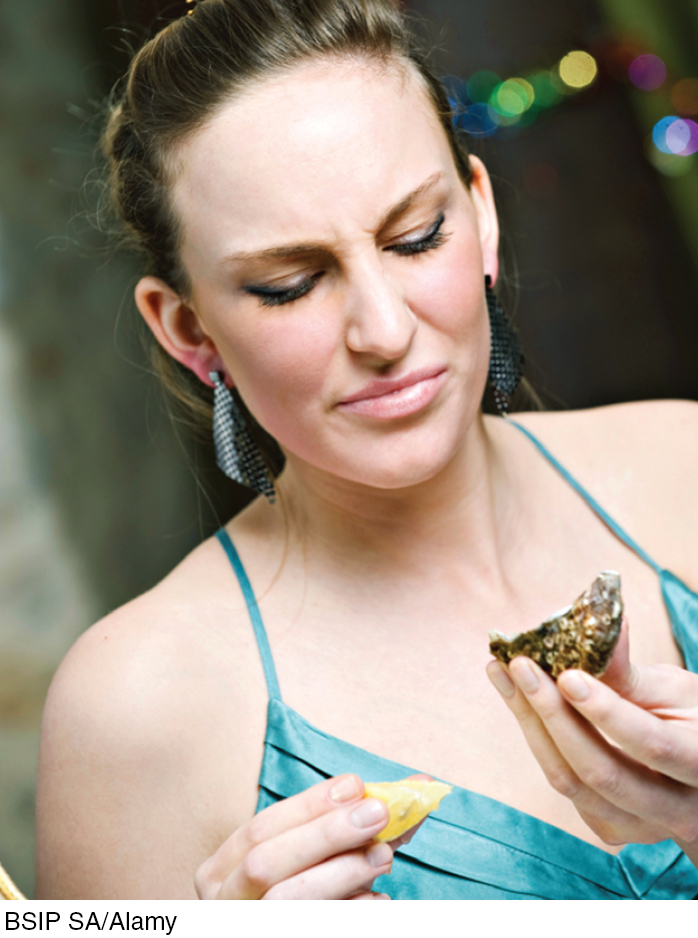
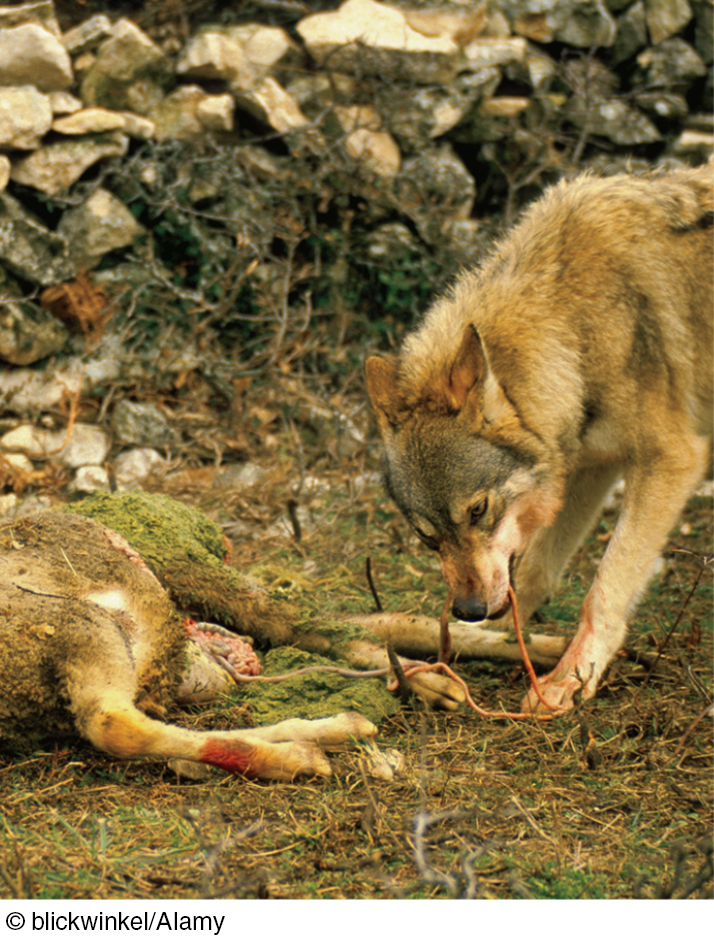
biological constraints evolved biological tendencies that predispose animals’ behavior and learning. Thus, certain behaviors are more easily learned than others.
In 1956, learning researcher Gregory Kimble proclaimed, “Just about any activity of which the organism is capable can be conditioned and … these responses can be conditioned to any stimulus that the organism can perceive” (p. 195). Twenty-
John Garcia was among those who challenged the prevailing idea that all associations can be learned equally well. While researching the effects of radiation on laboratory animals, Garcia and Robert Koelling (1966) noticed that rats began to avoid drinking water from the plastic bottles in radiation chambers. Could classical conditioning be the culprit? Might the rats have linked the plastic-
To test their hunch, Garcia and Koelling exposed the rats to a particular taste, sight, or sound (CS) and later also to radiation or drugs (US) that led to nausea and vomiting (UR). Two startling findings emerged: First, even if sickened as late as several hours after tasting a particular novel flavor, the rats thereafter avoided that flavor. This appeared to violate the widely held belief that for conditioning to occur, the US must immediately follow the CS.
Second, the sickened rats developed aversions to tastes but not to sights or sounds. This contradicted the behaviorists’ idea that any perceivable stimulus could serve as a CS. But it made adaptive sense. For rats, the easiest way to identify tainted food is to taste it; if sickened after sampling a new food, they thereafter avoid it. This response, called taste aversion, makes it difficult to eradicate a population of “bait-
Humans, too, seem biologically prepared to learn some associations rather than others. If you become violently ill four hours after eating contaminated oysters, you will probably develop an aversion to the taste of oysters but usually not to the sight of the associated restaurant, its plates, the people you were with, or the music you heard there. (In contrast, birds, which hunt by sight, appear biologically primed to develop aversions to the sight of tainted food [Nicolaus et al., 1983].)
268
Garcia and Koelling’s taste-
Such research supports Darwin’s principle that natural selection favors traits that aid survival. Our ancestors who readily learned taste aversions were unlikely to eat the same toxic food again and were more likely to survive and leave descendants. Nausea, like anxiety, pain, and other bad feelings, serves a good purpose. Like a car’s low-
The tendency to learn behaviors favored by natural selection may help explain why we humans seem naturally disposed to learn associations between the color red and sexuality. Female primates display red when nearing ovulation. In human females, enhanced bloodflow produces the red blush of flirtation and sexual excitation. Does the frequent pairing of red and sex—
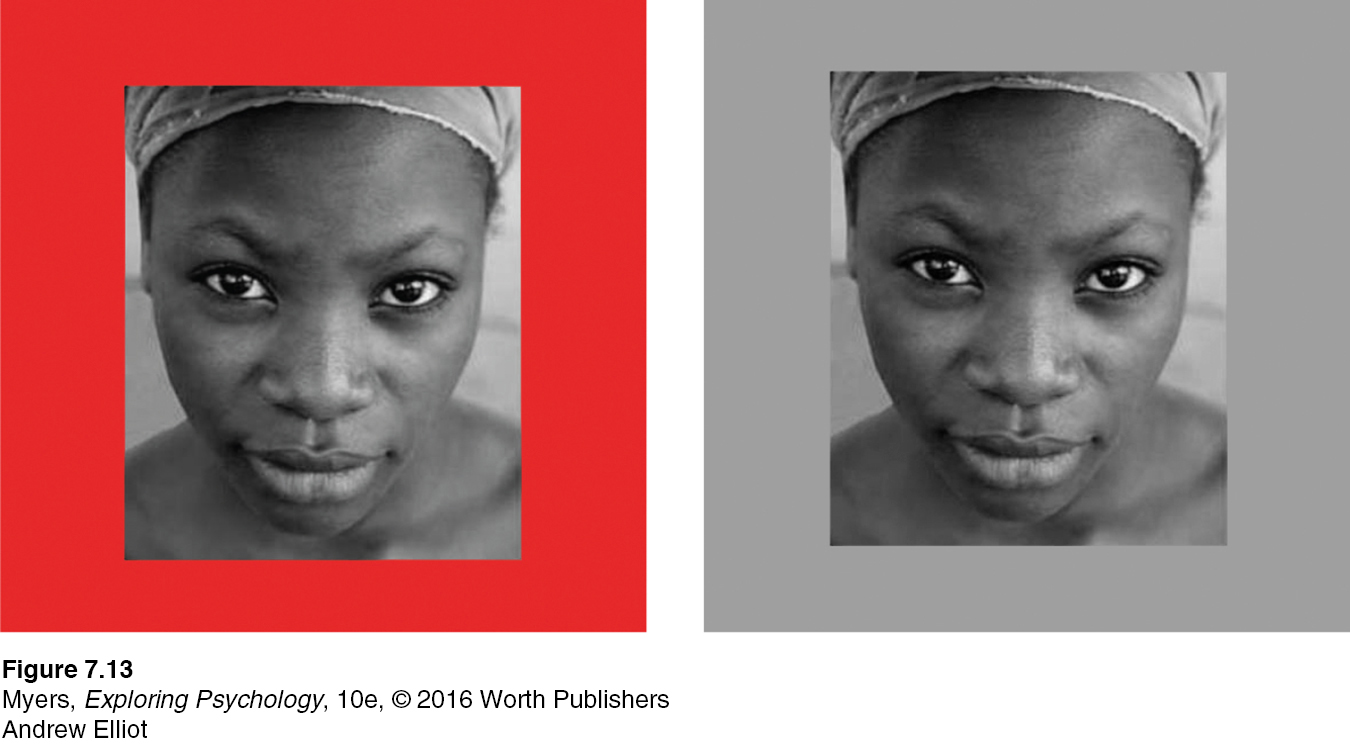
A genetic predisposition to associate a CS with a US that follows predictably and immediately is adaptive. Causes often do immediately precede effects. But as we saw in the taste-
269

RETRIEVE IT
Question
C7+o/D+LKHnO4TH/qJCL+2FFDs0UUW2DI6nffJOYBLiUanOpiwJ3JhKENljif11wcLKyaZkBt2lDEsM0OsuBYRncRVJgjcbZe4qrBnS3fHHPJnP5HmEc4oBS9ltpBen2CSp80kaP7eboPFJV5R2Kjs8sWim2cXumwmKgJTG0QZw+VKTqhICJGscUEMXzU/Zu0w4cEuVLQmnlC+tksjfese0YoUpjuIWNnGGXJ1uS03rO9Ik/KfZC3j5pm9BL5FG9r6BSrWnNdiRnSUEJtynylfv9hi0U60b+GKCV651WrMzDPytUoXcQ+7K/ZegdkhtFEgdOw2oBMrYtDJZe+tVVPraY6CYOKlUvy1YUH+au3R5E+nZh25NJK7B7yw5/mwKUC/b4cRWM1gcVzMW4QFXpy/1Dz82qa4xiZxTYsSMrxTiwurF07X78mw==Limits on Operant Conditioning
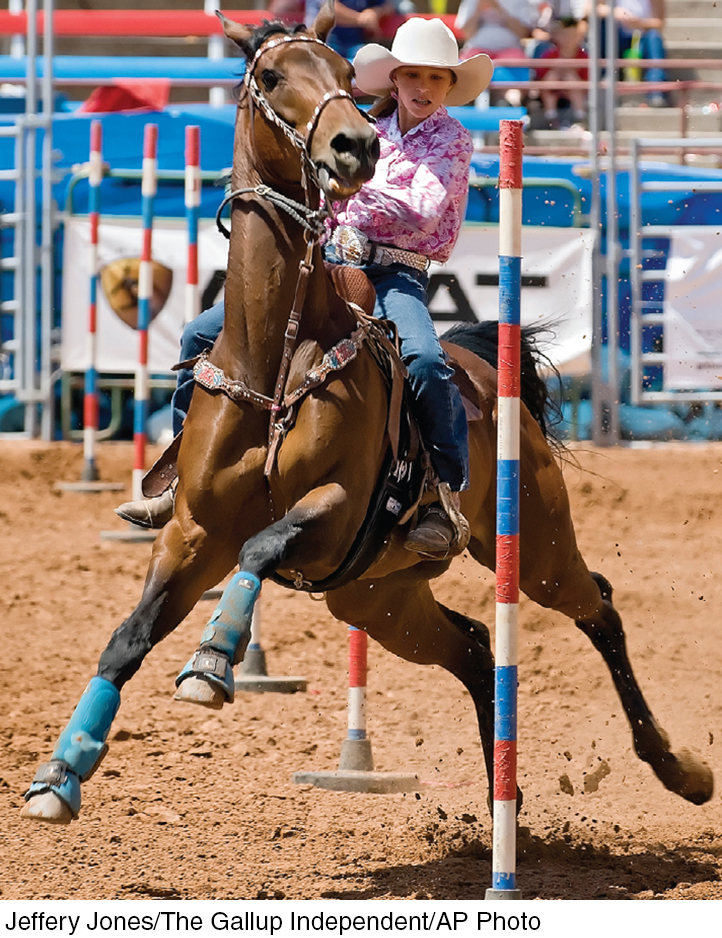
As with classical conditioning, nature sets limits on each species’ capacity for operant conditioning. Science fiction writer Robert Heinlein (1907–
“Once bitten, twice shy.”
G. F. Northall, Folk-
We most easily learn and retain behaviors that reflect our biological predispositions. Thus, using food as a reinforcer, you could easily condition a hamster to dig or to rear up, because these are among the animal’s natural food-
In the early years of their work, animal trainers Marian Breland and Keller Breland presumed that operant principles would work on almost any response an animal could make. But they, too, learned about biological constraints. In one act, pigs trained to pick up large wooden “dollars” and deposit them in a piggy bank began to drift back to their natural ways. They dropped the coin, pushed it with their snouts as pigs are prone to do, picked it up again, and then repeated the sequence—
Cognition’s Influence on Conditioning
7-
270
Cognition and Classical Conditioning
In their dismissal of “mentalistic” concepts such as consciousness, Pavlov and Watson underestimated the importance not only of biological constraints, but also the effects of cognitive processes (thoughts, perceptions, expectations). The early behaviorists believed that rats’ and dogs’ learned behaviors could be reduced to mindless mechanisms, so there was no need to consider cognition. But Robert Rescorla and Allan Wagner (1972) showed that an animal can learn the predictability of an event. If a shock always is preceded by a tone, and then may also be preceded by a light that accompanies the tone, a rat will react with fear to the tone but not to the light. Although the light is always followed by the shock, it adds no new information; the tone is a better predictor. The more predictable the association, the stronger the conditioned response. It’s as if the animal learns an expectancy, an awareness of how likely it is that the US will occur.
For more information on animal behavior, see books by (we are not making this up) Robin Fox and Lionel Tiger.
“All brains are, in essence, anticipation machines.”
Daniel C. Dennett, Consciousness Explained, 1991
Classical conditioning treatments that ignore cognition often have limited success. For example, people receiving therapy for alcohol use disorder may be given alcohol spiked with a nauseating drug. Will they then associate alcohol with sickness? If classical conditioning were merely a matter of “stamping in” stimulus associations, we might hope so, and to some extent this does occur (as we will see in Chapter 15). However, one’s awareness that the nausea is induced by the drug, not the alcohol, often weakens the association between drinking alcohol and feeling sick. So, even in classical conditioning, it is—
Cognition and Operant Conditioning
B. F. Skinner acknowledged the biological underpinnings of behavior and the existence of private thought processes. Nevertheless, many psychologists criticized him for discounting cognition’s importance.
A mere eight days before dying of leukemia in 1990, Skinner stood before the American Psychological Association convention. In this final address, he again resisted the growing belief that cognitive processes have a necessary place in the science of psychology and even in our understanding of conditioning. He viewed “cognitive science” as a throwback to early twentieth-
Nevertheless, the evidence of cognitive processes cannot be ignored. For example, animals on a fixed-
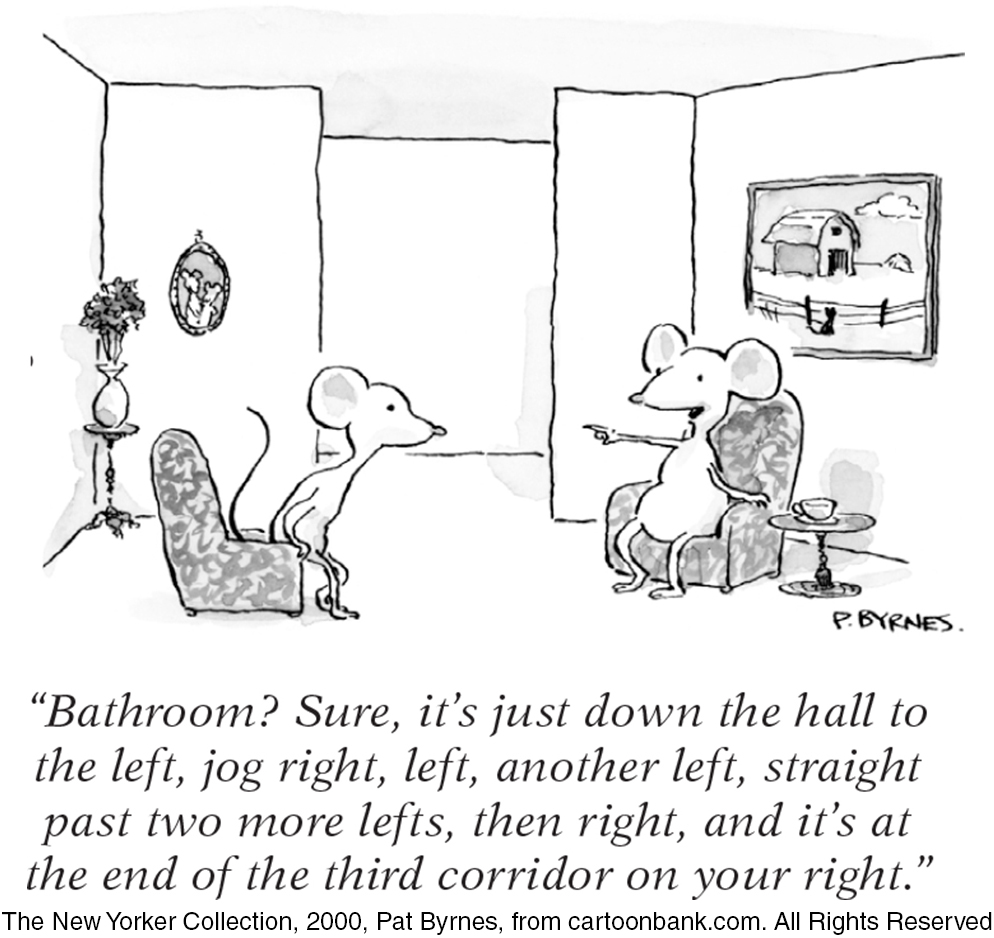
cognitive map a mental representation of the layout of one’s environment. For example, after exploring a maze, rats act as if they have learned a cognitive map of it.
latent learning learning that occurs but is not apparent until there is an incentive to demonstrate it.
Evidence of cognitive processes has also come from studying rats in mazes. Rats exploring a maze, given no obvious rewards, seem to develop a cognitive map, a mental representation of the maze. When an experimenter then places food in the maze’s goal box, these rats run the maze as quickly and efficiently as other rats that were previously reinforced with food for this result. Like people sightseeing in a new town, the exploring rats seemingly experienced latent learning during their earlier tours. That learning became apparent only when there was some incentive to demonstrate it. Children, too, may learn from watching a parent but demonstrate the learning only much later, as needed. The point to remember: There is more to learning than associating a response with a consequence; there is also cognition. In Chapter 9, we will encounter more striking evidence of animals’ cognitive abilities in solving problems and in using aspects of language.

intrinsic motivation a desire to perform a behavior effectively for its own sake.
271
The cognitive perspective has also shown us the limits of rewards: Promising people a reward for a task they already enjoy can backfire. Excessive rewards can destroy intrinsic motivation—
extrinsic motivation a desire to perform a behavior to receive promised rewards or avoid threatened punishment.
To sense the difference between intrinsic motivation and extrinsic motivation (behaving in certain ways to gain external rewards or avoid threatened punishment), think about your experience in this course. Are you feeling pressured to finish this reading before a deadline? Worried about your grade? Eager for the credits that will count toward graduation? If Yes, then you are extrinsically motivated (as, to some extent, almost all students must be). Are you also finding the material interesting? Does learning it make you feel more competent? If there were no grade at stake, might you be curious enough to want to learn the material for its own sake? If Yes, intrinsic motivation also fuels your efforts.
Youth sports coaches who aim to promote enduring interest in an activity, not just to pressure players into winning, should focus on the intrinsic joy of playing and of reaching one’s potential (Deci & Ryan, 1985, 2009). Doing so may also ultimately lead to greater rewards. Students who focus on learning (intrinsic reward) often get good grades and graduate (extrinsic rewards). Doctors who focus on healing (intrinsic) may make a good living (extrinsic). Indeed, research suggests that people who focus on their work’s meaning and significance not only do better work but ultimately enjoy more extrinsic rewards (Wrzesniewski et al., 2014).
Nevertheless, extrinsic rewards used to signal a job well done (rather than to bribe or control someone) can be effective (Boggiano et al., 1985). “Most improved player” awards, for example, can boost feelings of competence and increase enjoyment of a sport. Rightly administered, rewards can improve performance and spark creativity (Eisenberger & Aselage, 2009; Henderlong & Lepper, 2002). And the rewards that often follow academic achievement, such as scholarships and jobs, are here to stay.
TABLE 7.5 compares the biological and cognitive influences on classical and operant conditioning.
Biological and Cognitive Influences on Conditioning
| Classical Conditioning | Operant Conditioning | |
|---|---|---|
| Biological predispositions | Natural predispositions constrain what stimuli and responses can easily be associated. | Organisms most easily learn behaviors similar to their natural behaviors; unnatural behaviors instinctively drift back toward natural ones. |
| Cognitive processes | Organisms develop expectation that CS signals the arrival of US. | Organisms develop expectation that a response will be reinforced or punished; they also exhibit latent learning, without reinforcement. |
272
RETRIEVE IT
Question
zCJXTmA8eBfdCuOHhESblikicAlfxAchF6DjSUQ+Klu+H96de0JAtKE3ZwC6wlLJTL+VXFVN2NhgcK6TcjoXxe33fllsWLQJHDLz7TgWs1JCl3UBrIvdWmkKZRyppute2Cif8ovehnZWGgaMLkXzO2ZulWrpWZDhLearning by Observation
7-
observational learning learning by observing others.
modeling the process of observing and imitating a specific behavior.
 For three minutes of classic footage, see LaunchPad’s Video: Bandura’s Bobo Doll Experiment.
For three minutes of classic footage, see LaunchPad’s Video: Bandura’s Bobo Doll Experiment.
Cognition supports observational learning, in which higher animals, especially humans, learn without direct experience, by watching and imitating others. A child who sees his sister burn her fingers on a hot stove learns not to touch it. We learn our native languages and various other specific behaviors by observing and imitating others, a process called modeling.
Picture this scene from an experiment by Albert Bandura, the pioneering researcher of observational learning (Bandura et al., 1961): A preschool child is working on a drawing, while an adult in another part of the room builds with Tinkertoys. As the child watches, the adult gets up and for nearly 10 minutes pounds, kicks, and throws around the room a large inflated Bobo doll, yelling, “Sock him in the nose… . Hit him down… . Kick him.”
The child is then taken to another room filled with appealing toys. Soon the experimenter returns and tells the child she has decided to save these good toys “for the other children.” She takes the now-
Compared with children not exposed to the adult model, those who viewed the model’s actions were more likely to lash out at the doll. Observing the aggressive outburst apparently lowered their inhibitions. But something more was also at work, for the children imitated the very acts they had observed and used the very words they had heard (FIGURE 7.15).
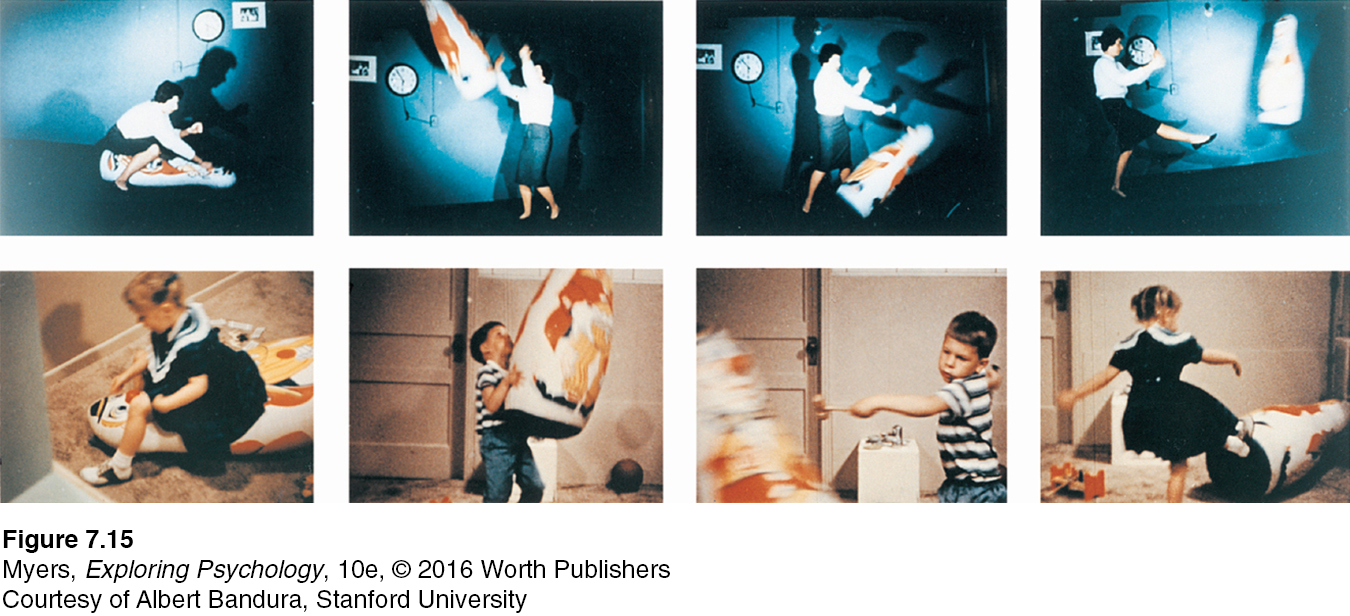
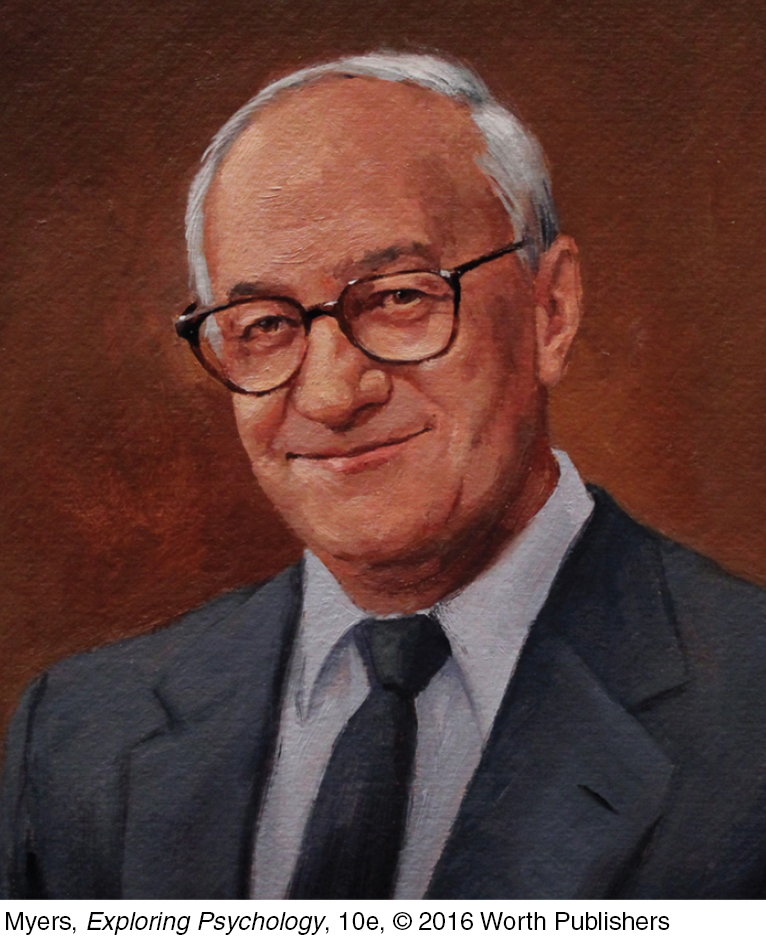
That “something more,” Bandura suggested, was this: By watching models, we experience vicarious reinforcement or vicarious punishment, and we learn to anticipate a behavior’s consequences in situations like those we are observing. We are especially likely to learn from people we perceive as similar to ourselves, or as successful, or as admirable. fMRI scans show that when people observe someone winning a reward (and especially when it’s someone likable and similar to themselves), their own brain reward systems activate, much as if they themselves had won the reward (Mobbs et al., 2009). When we identify with someone, we experience their outcomes vicariously. Even our learned fears may extinguish as we observe another safely navigating the feared situation (Golkar et al., 2013). Lord Chesterfield (1694-
Mirrors and Imitation in the Brain
273
On a 1991 hot summer day in Parma, Italy, a lab monkey awaited its researchers’ return from lunch. The researchers had implanted wires next to its motor cortex, in a frontal lobe brain region that enabled the monkey to plan and enact movements. The monitoring device would alert the researchers to activity in that region of the monkey’s brain. When the monkey moved a peanut into its mouth, for example, the device would buzz. That day, as one of the researchers reentered the lab, ice cream cone in hand, the monkey stared at him. As the researcher raised the cone to lick it, the monkey’s monitor buzzed—

mirror neurons frontal lobe neurons that some scientists believe fire when performing certain actions or when observing another doing so. The brain’s mirroring of another’s action may enable imitation and empathy.
The same buzzing had been heard earlier, when the monkey watched humans or other monkeys move peanuts to their mouths. The flabbergasted researchers had, they believed, stumbled onto a previously unknown type of neuron (Rizzolatti et al., 2002, 2006). These presumed mirror neurons, they argued, provide a neural basis for everyday imitation and observational learning. When a monkey grasps, holds, or tears something, these neurons fire. And they likewise fire when the monkey observes another doing so. When one monkey sees, its neurons mirror what another monkey does. (For a debate regarding the importance of mirror neurons, which are sometimes overblown in the popular press, see Gallese et al., 2011; Hickok, 2014.)
Imitation is widespread in other species. Chimpanzees observe and imitate all sorts of novel foraging and tool use behaviors, which are then transmitted from generation to generation within their local culture (Hopper et al., 2008; Whiten et al., 2007). So, too, with monkeys. Researchers trained groups of vervet monkeys to prefer either blue or pink corn by soaking one color in a disgusting-
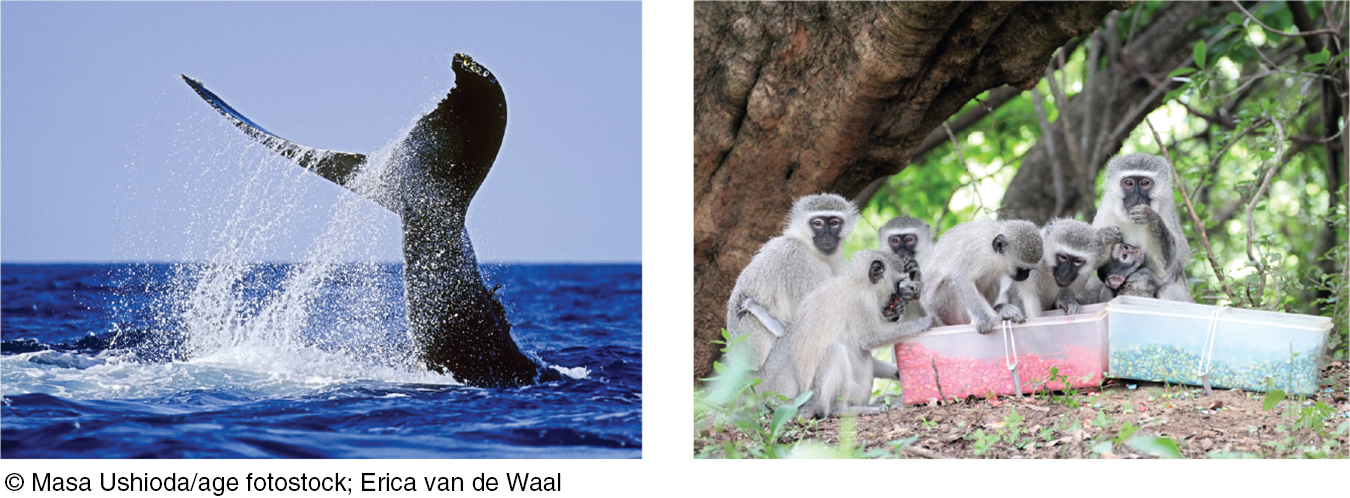
274
In humans, imitation is pervasive. Our catchphrases, fashions, ceremonies, foods, traditions, morals, and fads all spread by one person copying another. Children and even infants are natural imitators (Marshall & Meltzoff, 2014). Shortly after birth, babies may imitate adults who stick out their tongue. By 8 to 16 months, infants imitate various novel gestures (Jones, 2007). By 12 months (FIGURE 7.16), they look where an adult is looking (Meltzoff et al., 2009). And by 14 months, children imitate acts modeled on TV (Meltzoff, 1988; Meltzoff & Moore, 1989, 1997). Even as 2½-year-

So strong is the human predisposition to learn from watching adults that 2-
Humans, like monkeys, have brains that support empathy and imitation. Researchers cannot insert experimental electrodes in human brains, but they can use fMRI scans to see brain activity associated with performing and with observing actions. So, is the human capacity to simulate another’s action and to share in another’s experience due to specialized mirror neurons? Or is it due to distributed brain networks? That issue is currently being debated (Gallese et al., 2011; Iacoboni, 2008, 2009; Mukamel et al., 2010; Spaulding, 2013). Regardless, children’s brains do enable their empathy and their ability to infer another’s mental state, an ability known as theory of mind.
“Children need models more than they need critics.”
Joseph Joubert, Pensées, 1842
The brain’s response to observing others makes emotions contagious. Through its neurological echo, our brain simulates and vicariously experiences what we observe. So real are these mental instant replays that we may misremember an action we have observed as an action we have performed (Lindner et al., 2010). But through these reenactments, we grasp others’ states of mind. Observing others’ postures, faces, voices, and writing styles, we unconsciously synchronize our own to theirs—
Seeing a loved one’s pain, our faces mirror the other’s emotion. But as FIGURE 7.17 shows, so do our brains. In this fMRI scan, the pain imagined by an empathic romantic partner triggered some of the same brain activity experienced by the loved one who actually had the pain (Singer et al., 2004). Even fiction reading may trigger such activity, as we mentally simulate (and vicariously experience) the feelings and actions described (Mar & Oatley, 2008; Speer et al., 2009). In one experiment, university students read (and vicariously experienced) a fictional fellow student’s description of overcoming obstacles to vote. A week later, those who read the first-
275
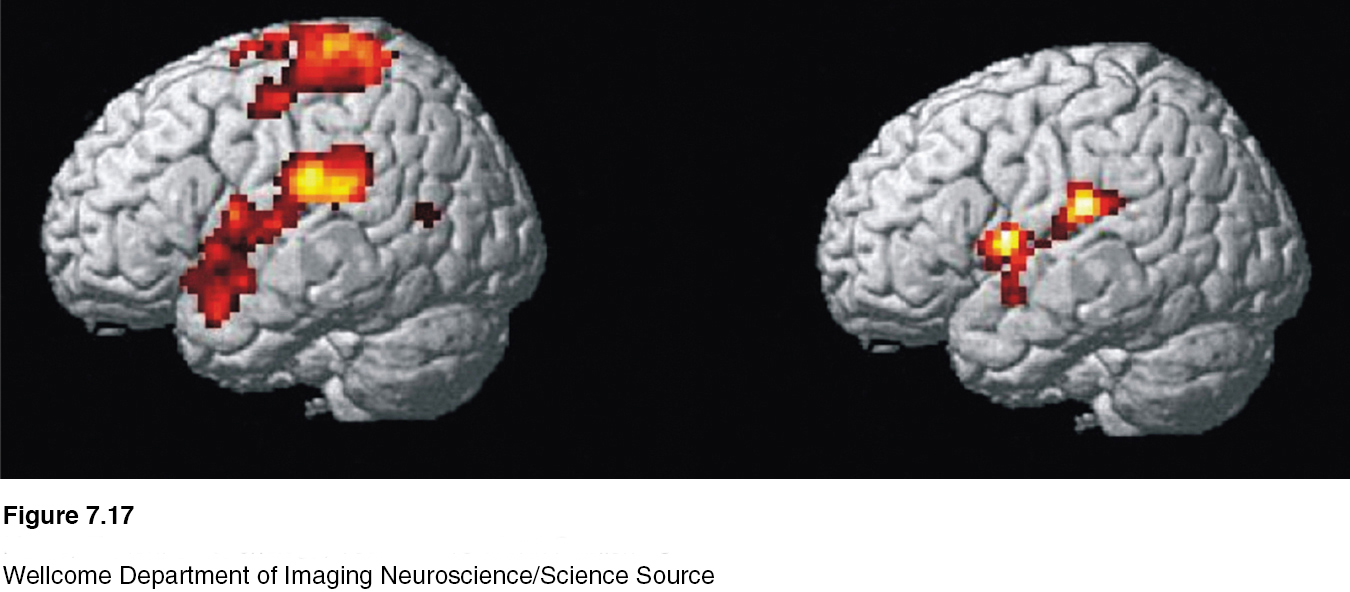
Applications of Observational Learning
7-
So the big news from Bandura’s studies and the mirror-
prosocial behavior positive, constructive, helpful behavior. The opposite of antisocial behavior.
PROSOCIAL EFFECTS The good news is that prosocial (positive, helpful) models can have prosocial effects. Many business organizations effectively use behavior modeling to help new employees learn communication, sales, and customer service skills (Taylor et al., 2005). Trainees gain these skills faster when they are able to observe the skills being modeled effectively by experienced workers (or actors simulating them).
People who exemplify nonviolent, helpful behavior can also prompt similar behavior in others. India’s Mahatma Gandhi and America’s Martin Luther King, Jr., both drew on the power of modeling, making nonviolent action a powerful force for social change in both countries. The media offer models. For example, one research team found that across seven countries, viewing prosocial TV, movies, and video games boosted later helping behavior (Prot et al., 2014).
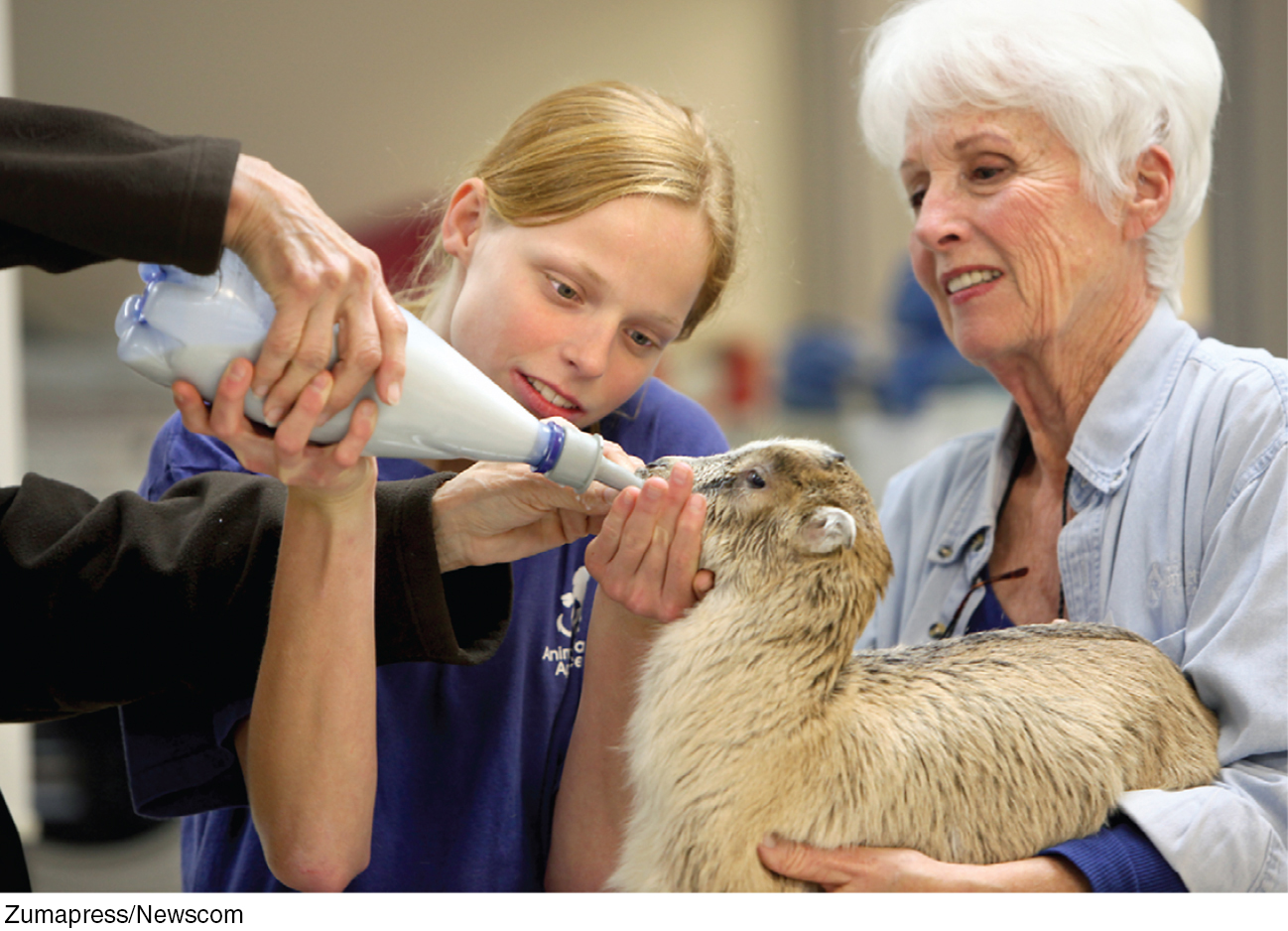
276
Parents are also powerful models. European Christians who risked their lives to rescue Jews from the Nazis usually had a close relationship with at least one parent who modeled a strong moral or humanitarian concern; this was also true for U.S. civil rights activists in the 1960s (London, 1970; Oliner & Oliner, 1988). The observational learning of morality begins early. Socially responsive toddlers who readily imitated their parents tended to become preschoolers with a strong internalized conscience (Forman et al., 2004).
Models are most effective when their actions and words are consistent. Sometimes, however, models say one thing and do another. To encourage children to read, read to them and surround them with books and people who read. To increase the odds that your children will practice your religion, worship and attend religious activities with them. Many parents seem to operate according to the principle “Do as I say, not as I do.” Experiments suggest that children learn to do both (Rice & Grusec, 1975; Rushton, 1975). Exposed to a hypocrite, they tend to imitate the hypocrisy—
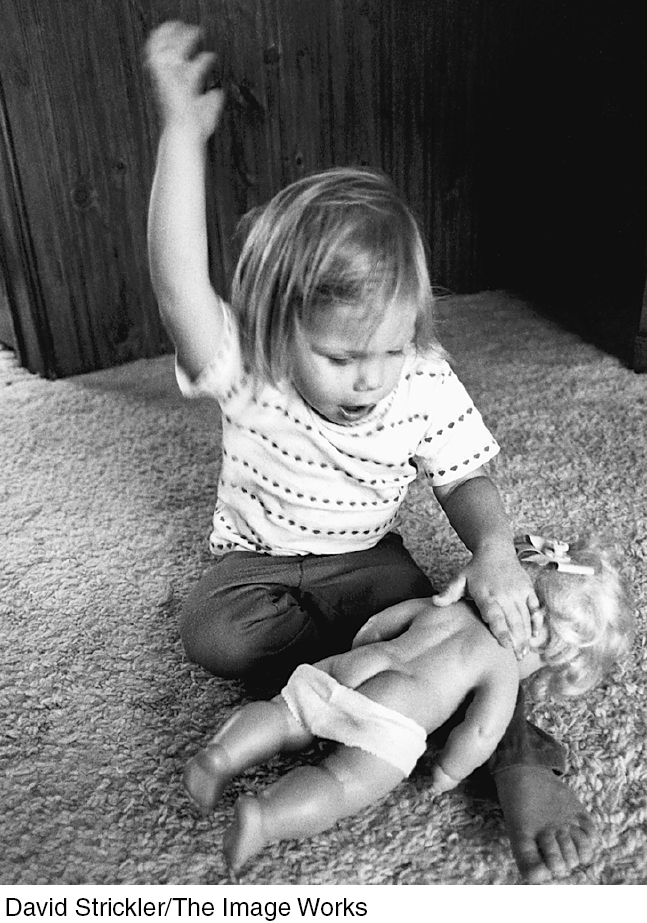
ANTISOCIAL EFFECTS The bad news is that observational learning may also have antisocial effects. This helps us understand why abusive parents might have aggressive children, and why many men who beat their wives had wife-
“The problem with television is that the people must sit and keep their eyes glued to a screen: The average American family hasn’t time for it. Therefore the showmen are convinced that … television will never be a serious competitor of [radio] broadcasting.”
New York Times, 1939
TV shows, movies, and online videos are sources of observational learning. While watching, children may learn that bullying is an effective way to control others, that free and easy sex brings pleasure without later misery or disease, or that men should be tough and women gentle. And they have ample time to learn such lessons. During their first 18 years, most children in developed countries spend more time watching TV than they spend in school. The average teen averages, across 365 days a year, more than 4 hours a day; the average adult, 3 hours (Robinson & Martin, 2009; Strasburger et al., 2010).
Screen time’s greatest effect may stem from what it displaces. Children and adults who spend several hours a day in front of a screen spend that many fewer hours in other pursuits—
Viewers are learning about life from a rather peculiar storyteller, one that reflects the culture’s mythology but not its reality. Between 1998 and 2006, prime-
277
THINKING CRITICALLY ABOUT
Does Viewing Media Violence Trigger Violent Behavior?
Was the judge who in 1993 tried two British 10-
Correlational studies do support this link:
In the United States and Canada, homicide rates doubled between 1957 and 1974, just when TV was introduced and spreading. Moreover, census regions with later dates for TV service also had homicide rates that jumped later (Centerwall, 1989).
White South Africans were first introduced to TV in 1975. A similar near-
doubling of the homicide rate began after 1975 (Centerwall, 1989). Elementary schoolchildren heavily exposed to media violence (via TV, videos, and video games) tend to get into more fights (FIGURE 7.18). As teens, they are at greater risk for violent behavior (Boxer et al., 2009).
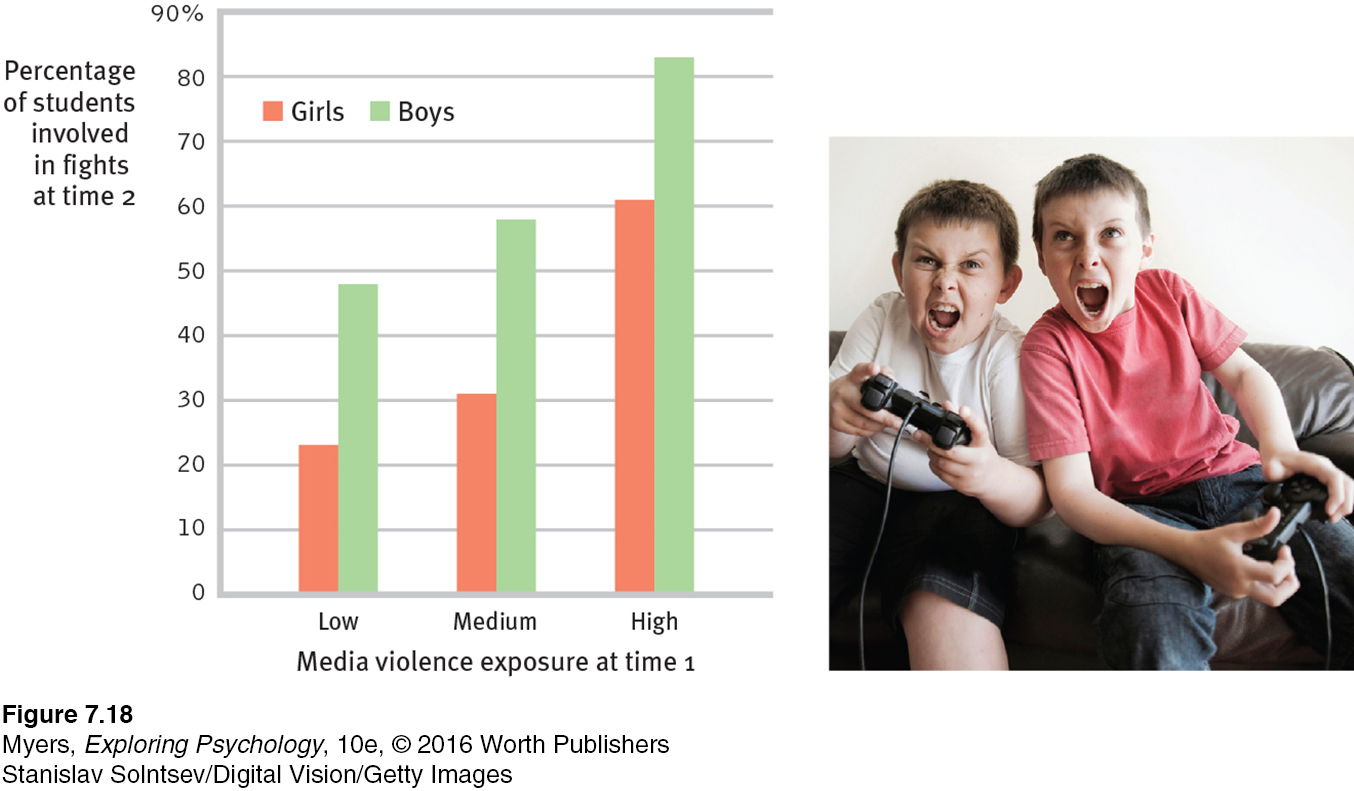
But as we know from Chapter 1, correlation need not mean causation. So correlational studies like these do not, as critics remind us, prove that viewing violence causes aggression (Ferguson, 2009; Freedman, 1988; McGuire, 1986). Maybe aggressive children prefer violent programs. Maybe abused or neglected children are both more aggressive and more often left in front of the TV, video-
To pin down causation, psychologists have experimented. They randomly assigned some viewers to observe violence and others to watch entertaining nonviolence. Does viewing cruelty prepare people, when irritated, to react more cruelly? To some extent, it does. This is especially so when an attractive person commits seemingly justified, realistic violence that goes unpunished and causes no visible pain or harm (Donnerstein, 1998, 2011).
The violence-
Prolonged exposure to violence also desensitizes viewers. They become more indifferent to it when later viewing a brawl, whether on TV or in real life (Fanti et al., 2009; Rule & Ferguson, 1986). Adult males who spent three evenings watching sexually violent movies became progressively less bothered by the rapes and slashings shown. Compared with those in a control group, the film watchers later expressed less sympathy for domestic violence victims, and they rated the victims’ injuries as less severe (Mullin & Linz, 1995). Likewise, moviegoers were less likely to help an injured woman pick up her crutches if they had just watched a violent rather than a nonviolent movie (Bushman & Anderson, 2009).
Drawing on such findings, the International Society for Research on Aggression’s Media Violence Commission (2012) concluded that violent media are not the primary cause of school shootings, but that “exposure to media violence is one risk factor for increased aggression.” And the American Academy of Pediatrics (2009) has advised pediatricians that “media violence can contribute to aggressive behavior, desensitization to violence, nightmares, and fear of being harmed.” Indeed, an evil psychologist could hardly imagine a better way to make people indifferent to brutality than to expose them to a graded series of scenes, from fights to killings to the mutilations in slasher movies (Donnerstein et al., 1987). Watching cruelty fosters indifference.
“Thirty seconds worth of glorification of a soap bar sells soap. Twenty-
U.S. Senator Paul Simon, Remarks to the Communitarian Network, 1993
278
RETRIEVE IT
Question
L5h+WFqeM22te86ldMQCD6VR7gtjir5rQDyrvtXbrcn8o+KzFMZynX9jbb95rKIXR5nKC4LDaJy2kGc4BFQ6YsKPM1r6nHBLKFRd8Fv2NAOLhKlR6WYrbgf/ndm2MFP0MneAOagL53wIx6/BLzU2til8sFK84/56wQAyrHnPfxjT5i9iMMDdAEntuUs5/20k8gXDuCPNc8YDvasQ1JPxTlCqXVu99W+71F69cOia9gnj3dkmz2K9bpdOFf5xEW0qep/rGc+jcpQQ6T/d2csGs476NdaJk5hczdRAaPYaLvbbqTxlR4mwk1eu8xE1jSvHTUCorr4TQ4Ey7/O14gSCxrmSgWI=* * *
Our knowledge of learning principles comes from the work of hundreds of investigators. This chapter has focused on the ideas of a few pioneers—
RETRIEVE IT
Match the examples to the appropriate underlying learning principle:
Question
BHESTjcHzTt0YLXgR4m4smNQCECdOzxpZeMBnNoolKgL3YMGtJf1+1OuMnh7zhs+ScsAwt2eqqteLgRAGuJEJxvQ6LhAh4xDUTsKT7Mc+GJtKQNVi5Vv6vpdUmuYM0YPOijGRgA2hK0sjqAHHROHTI5mPd29FHgj23KoYjuSzoI7bT8W704Nahw3bc38+22cwSQCJ8Cx1EM8VGUEm/H/CAlIiORp1n9biqKXTp9IQJsk95EwcHXIVI8vKq2jAEF3tfL6piRewhsomcWbYX3EG6PqhpqGsmI0LNKWbcWBs/Iy9IVfhcuS4IyWmMx9pufnkaVP991N7ppmAk+XXPJGsnmfLQDGb2QHcDGvT7imbcs39Bd6tMVkrEfWxB8g1xHx0Bfo5juEsjcAgKUJCrMtNeg56gG8lvzHJJ3sPhR52QhoJ3I6UUW92QsN8vONf6loGGpu/oh6RPkC0DMZO7fI4K9Nw/W8CaGT28xKYWaOHZmPWkhSrtccq/faFR6xzp6CgtKjH7O0fw0kT/e8HBaocpcL49PDJCidprV1FZcPE+kzfSFZwySopYpwagJEVo2MiWhTFPZVJ+DdgXuKklqTY8Xk/4A=Learning Objectives
279
Test Yourself by taking a moment to answer each of these Learning Objective Questions (repeated here from within the chapter). Research suggests that trying to answer these questions on your own will improve your long-
Question
oWUPGkO+HTVgk6MFu7rCpq7cNVz2sH+laAADXZV3p+X8bR5BjcGDcUKtdVWFP0nCrVD+z17z/+ZTfqB6zK/tOyGqI1lClBhPTBpQ0mn8hu0PNt7z6hcxYwzDX7ZFgpFKzDkmjGQjYlAiCszJ27LYiBbJ2Am4J5lENX9Hd1II0g++jZlVLLvM4n0FkJv7ZKip21jlmaWu8o8OkEalDKeTp9bTbyMkKu/283C6V4bEdktI8uLpXcFiHCi4+mY=Question
/MC9h+vwEO7c3pvtw23Rf3MGzFq4CufbNykQSykP97QUAbpu6RYERHaTMUwZdmnjsyZG6Wsyx168dsZRXk6nRE3ljjyRKTsAL2z7eXIpZUrpdkkNYX647T8d54/TzNvtu0uAOBWiRFRmgJ+sPsAgRCE0lFfgwdHcsdASgi+w3YBsijhnNAqoWYNGwKlyqI72gqk6GH12VkqiE19/9+L20sx1rdAUFORzzt/pOsOCrY2ENzTJrXCeww==Question
9fzth1VBqS70khqFkW+Sz2x6fEfYKQSL/es1bxrX1a1tJDhpDllZ5UDfbT/iMFoBynLx1yT5ypGY8uAKqS2+vDzyloIBiIcjaPjFC8zhpIVaIJ+kmDFmOvdeJ2OYkPTNKfj/tu8YiUQxqJdc74nyYlQ5csWLNtRIUM2wSWDax/b7Rsb0GHOsseH31H9b3gMfhJPKNhZ4MbxrMAtAd9WZtZWyWgrLxhhL2E5FDmjox4N36Vl3bLhckY3PnqwJ43kJA4J5GcoQ3YEB/mfr6wSMpcfOiLwxehjXb2Wy8O1+tbx4uZngK0QcRD5gkiq92sCsxA9ExA==Question
v9OBqaGnB16fOKTATJI4/ceCW62ZPB0cdHDmcIx0zdb9gKmZPorajq97Mb2xAShu8iP6fiHnayKY+TDcsNYwBUP9aiZotBrWQ+l59mdwbMH8zp9YH8oduTSXqagLcR8OcE+7Br4BAt+nQpIIYH/mbODv4QrTeokgQl0J4UkEKPVYUFlkWJ1QZvq24qMcDxlX73cylOXVVwFVwD9hbs2gdyi7Mgw4svk3jEltWsIwbdZHGhNu+mCZXA==Terms and Concepts to Remember
Test yourself on these terms.
Question
dMmEjlg1bYUSC9tMGJ5h+LZTuIkSBy1XMO2g82itqOKxKs6Hgs7jnUcjGgyIhbuKkUryi+UJal/PotTUyDATBGbzv+bYRHZm1o+DtPLPh9S2sBqSFzEDj7O8eHQYZj/vzwp/JnV0u2OyIaqsCIHH1LdqU0mNzCWbg7sOoLukAOErSvIg9FLgWgJqpyL85d3+u6SV7qrY4t2H9L8AIbhy5/OipuAo/MYoLC22/8aLwV0up4EqJukkopP3wS3EX4GMVGc+Wdrw93N3FnZoa1LXLzwp/f2wsD0CznNh40UPjOWZwYfQC/GyH3k6mKLiU1KiA0qYQxw/33SkCnpWz9XHmMs5Y2VU8qRdIfOwsLoSOSFnKIFm+LXegI8w9/ER0a/BPva2ZT8ybbd1kNkuzFNppbrxCQsshv7IJ0gk1dGTvlfi9dndOdECajrujNJyZ9TOaFK0hSMmoZUcd+ruys76u/RsLwaGZg8yaAUyX/SJQUu03+IVY3gdCGofp5WwDNC5ND97NrI2/JJ6tkuuag0ZuG/sniyuyvkfDk/14Db2dNiy7g/52fvVeX463Z6QYCZ7poQ2ZxSFyz3MLKba/UOMCvnXZr39kpFjkecQdHLLe1LOc3w0ApJEzXsG2t67WAZn0B1OCMfBmU/Q4YSzAxAn9H6Z7rYEdcbGF4l/WP1XHiIubyNEXna/tA2F+Tv8yJ5dF3DMb0120WGqfTgdfNK+pITJcULJ2BrkEqClDMGOhaK0Nj5fxK7MPyo9E50x+wkDeC3LdtKqRDnSTRRDa0im4HGctuLmyJG1PweuVHoZYoRsQOaKJsqiOZUaUvBlclALBP76b1A8Zg6dD1pvQqt0vYpZ0f3BRts5iApdtoehKbUO9gL+xbdPH27dJXFpMcFi+iFCaQxEY7Mkpf2RYh+Th1Fpom2D8EnVIEy+0f29xm3TjQiHRihPW5Q96d7pZDP8lkEo12ag4vUV/nL7pcvxWmSF+IPqC9GKfs3+8Kvnb5GE+tP16AGe4CDNTh+7SlNGxuSX/5t+Z6wHagvQcuJuq+IBeVBcTaA5CB3W5pkVanl7dLfglZNGS21WPvG7TkMowyTxubntm4ePvxkbi/mOvP1R8jnvZvg/AxP1QA0mE8K6ijcUeeNuFvfuFr9ufJWD5/G46/FAG5NTPTHHRzuzJacdMdDX5D06W/C0DztWar0dwggXvXValX6sc27WxHaUZ+R9f9nUufqES76y4EaXf7KhxyaE13+JLfqNyKBZqH+RXSQcVj8nARuWoAhpf5IXvBEa0ct2rqGfMyOp8MozxWmKbxxc0ON7XK+aXborv5I1JmPKgN7Dc5IVGbq9yZzBl8UOjWOU+/fuviD67psgFZMKsuf2wKZ+xBhIkWJXO+3jWK+RTwSjCP39vjvXUoRgL2Xo2FqQIe9izBAPb1TiCM9hyCkMA5pmcOdSBVZsfvceF/It+j7ONWsnGbx5C7PjGHb25C5aZx3kCo7v1C96OCIFUXPTnRiw5A70hIvqb+CJKzS0rsABIHQklwgUJOGL+M7fOrCy9zEEjkxfkO11mRqvSAooLAV2GJcAjQ==Experience the Testing Effect
Test yourself repeatedly throughout your studies. This will not only help you figure out what you know and don’t know; the testing itself will help you learn and remember the information more effectively thanks to the testing effect.
Question 7.15
1. Garcia and Koelling's pS/GuH3ET0OBum53F5KsyLWnHvA= studies showed that conditioning can occur even when the unconditioned stimulus (US) does not immediately follow the neutral stimulus (NS).
Question 7.16
fzSYqaseVxDMVKB2gdiu6zvHJUi9Sem62v0TxL6tfgWJoxcON600jBVJrDFJjyzJE4ikprKj+KQK13S81i9WWoVfyNS1mz9QDruSzY/KTjiBIbV9vQHZGXNLH1f+XOvHDSrddAoniW1fHEk936jH5snWYJW76V/8kOiqr/Ao6aYt2r4FylT0cWDypBP3mAsAcDXhtLG/FaCcst0vwHt1wMCEzhow8LEfRpus+kZV1GhsOMHCws6uaZ9Md3W3u/r+zvXKpmo+w35NIv9ke86N0f54VzHrxACKUcI+Vl9mMR5FmQOayCtHwjP4Wi4TIvGXDBOlpNQ7duAtBXvQ/d5nKJjHRuxBbk/AQuestion 7.17
3. Evidence that cognitive processes play an important role in learning comes in part from studies in which rats running a maze develop fYNie+kRiECK1j5c1DH9mv+1suA= .
Question 7.18
4. Rats that explored a maze without any reward were later able to run the maze as well as other rats that had received food rewards for running the maze. The rats that had learned without reinforcement demonstrated 4k3qs+DaieQFi38aclm4GkJyHqo= .
Question 7.19
5. Children learn many social behaviors by imitating parents and other models. This type of learning is called K30U/RM9mxwNA1DCp8QrwuNWUlXe5R5jWCJsIw== .
Question 7.20
6. According to Bandura, we learn by watching models because we experience reinforcement or punishment 7GlVjxxx1qUJ0olkhm3YtA== .
Question 7.21
ye66dhfOC6I+TSsV+QMP3ljw4qfmzwLUMuC2ukDExUXIfkGVjItx5j/uMZCyauclLwGs21Af5pnkLGWLCLtg383dMHuykZYfRi+XwHJ+9dyUysc0RDGV/t3iW8cDNsXF4E/pHB2h3VuuGoqXmJ+ge5IokXZCCQtCLaj7ET2LpLs6EpeGq1H+5PihJL64gB6NqWI/vud+CPz41XbtJkjTIaeK1SM/Q9fMjdb8mZ2aL50WuTHQ0PQOyDsLJ1kwNEe6awF0X29ERq6lw1wJmVVXVhNi2Y/I/XfbuOLFjk45ETQiDa+n5r0VP0F9/ppkqgqfQIuFdtGYoDQiyITWfRFyPrV4Q7Sr3kWqTAUU/aQHMV3yWq/YA4AJikcdbzq8fydGkfQ22/i2pKuERhMuTympWjPZJb8OWhET4Dm7fP+dLbqX9o9ylkcANXoWvH7XlJPFXqqw8ygRcPvSMrWOzAux9GIJGPiB//foQuestion 7.22
8. Some scientists believe that the brain has uPlw4J7VMhQcp595 neurons that enable empathy and imitation.
Question 7.23
pj0oIm/we45pVv70vQKQK4K7qDR2TDZUOo/6rGGQLRhW3f20J1Dn+eVq2xEfWIvaAy1liH0QK4B6+2oi9xgCTD2MIogYVZ3gXHpRWd0kvXiuEL14k5wgdj38C2/274b+kVr5eYwl7Vc562itPWrz6uuicQCWyvdcxLfgcwcyqpRaGhgqPrE94HfFB03mAaVsZhYbxzm3V7eIk648rpj/E8h6VrdeDi5wVoeluKATmidCvvbAAsvaWw3OqtMB1jMtD7rBvaafadMTXp2qJ6sciyE/mqpsPzR/RuNsRFBFx7sC1N0er+wUvIhzfI8yVTkEg0Cg9aUrG6FB4Hxy8Pxks6neUWjxkoqRuyaPMADrsZu5+xicUse  to create your personalized study plan, which will direct you to the resources that will help you most in
to create your personalized study plan, which will direct you to the resources that will help you most in  .
.